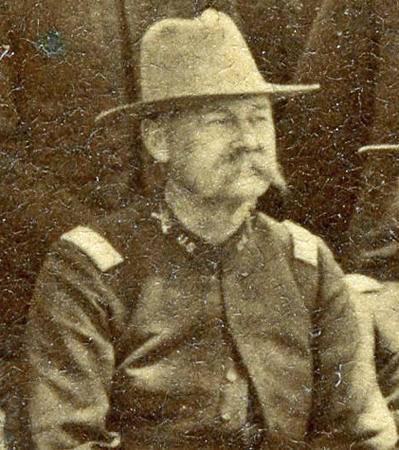

Lieutenant Colonel John Henry Patterson
Commander 22nd Infantry
June 20 - July 1, 1898
Lieutenant Colonel John H.
Patterson had been second-in-command of the 22nd Infantry
for nearly three years when, on June 14, 1898 the regiment sailed
onboard the Orizaba for Cuba.
On June 20, while still at sea, Colonel Charles Wikoff, Commander
of the 22nd Infantry received
orders assigning him to command the 3rd Brigade, 1st Division,
5th Army Corps.
LTC Patterson assumed command of
the 22nd and led them ashore at Daiquiri on June 22, 1898
thus being in command of the first U.S. Army regiment to unfurl
its colors on Cuban soil.
The 22nd Infantry led the
advance toward Santiago and was in 1st Brigade as part of
Lawton's 2nd Division,
sent north to secure the garrisoned city of El Caney which
guarded the northeastern approaches
to Santiago itself.
In the battle for El Caney the
22nd Infantry was positioned west of the city
to prevent the Spaniards from retreating to Santiago, some three
miles away.
The 1st Battalion of the 22nd, led by Company A, approached the
outskirts of El Caney
and were within 1000 yards of the city when they received intense
fire
from the Mauser rifles of the Spaniards.
Lieutenant Colonel Patterson was
with 1st Battalion at this time, directing the deployment of the
troops
and was severely wounded by the sudden enemy attack. He had to be
evacuated from the battlefield
and Major William M. Van Horne then assumed command of the
regiment.
In his official after-action
report to General Shafter, Brigadier General William Ludlow,
commanding First Brigade, described the action:
"The
First Brigade was moved rapidly forward toward Caney, and,
arriving about 1,000 or 1,200 yards therefrom,
was greeted by a sharp Mauser fire that swept the roads and cut
the leaves from the trees. The brigade was
immediately deployed, the Eighth Infantry on the left; First
Battalion, Twenty-second Infantry, the center;
and the Second Massachusetts on the right. The Second Battalion
of the Twenty-second Infantry had not yet
come in from skirmishing, having been delayed by thick chaparral
and failing to get the later order to return.
Subsequently it was disposed on the left of the Eighth, and did
admirable service.
While deploying his command, Lieutenant-Colonel Patterson, of the
Twenty-Second Infantry ,was shot in the groin,
and the command of the regiment devolved on Major Van
Horne."
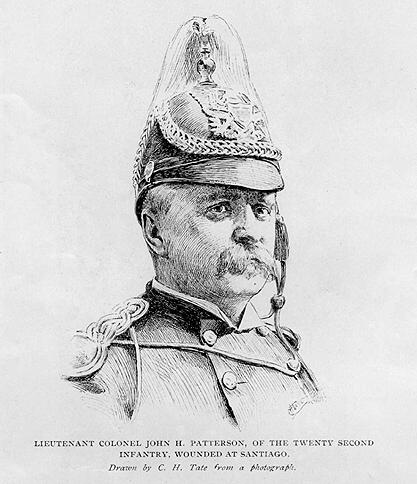
An illustration of LTC John H.
Patterson which appeared in
Munsey's Magazine Vol.
XIX No. 6 September 1898
Born in New York on February 10,
1843, John H. Patterson was appointed from New York
as a 1st Lieutenant in the 11th Infantry on May 14, 1861, a
position which he accepted on July 8, 1861.
He served in the field in the Army of the Potomac until he went
on recruiting duty
from August 1862 to March 1863.
He returned to the field and was
given a Brevet promotioin to Captain on October 1, 1864
for gallant service in the Battle of Chappel House, VA.
From September 19 to November 1,
1864 he was detailed as an Aide-de-camp of Volunteers.
He again served on recruiting duty from February to November,
1865.
During the war Patterson was
engaged at the siege of Yorktown, in the battles of Gaines' Mill
and Malvern Hill, Virginia; battles of Chancellorsville,
Virginia, Gettysburg, Pennsylvania,
Rappahannock Station, operations at Mine Run, battles of the
Wilderness, Spottsylvania,
North Anna River, Bethesda Church, Petersburg, Weldon Railroad,
Chapel House and
Hatcher's Run, Virginia.
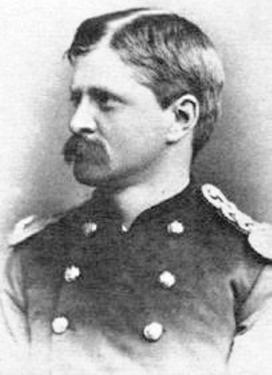
John H. Patterson as a young Infantry officer
Photo from the 16th Infantry Regiment Association website
Transferred to 20th Infantry
September 21, 1866.
Promoted to Captain July 26, 1866.
Promoted to Major of the 3rd Infantry May 19, 1891.
Promoted to Lieutenant Colonel of the 1st Infantry January 21,
1895.
Transferred to the 22nd Infantry November 4, 1895.
Awarded the Medal of Honor on July 23, 1897, for
gallantry in action, May 5, 1864.
Assumed command of the 22nd Infantry June 20, 1898
Wounded at El Caney, Cuba, July 1, 1898 .
Appointed Brigadier General of Volunteers, September 21, 1898.
Promoted to Colonel of the 20th Infantry September 28, 1898.
(Note: Upon leaving the 22nd Infantry Patterson never joined the
20th Infantry Regiment.
He served as Volunteer Mustering Officer for the State of New
Jersey until his retirement.)
Honorably discharged from the Volunteers November 30, 1898.
Promoted to Brigadier General January 18, 1899.
Retired (for over thirty years service) February 6, 1899.
John H. Patterson was an Original Companion of the Military Order of the Loyal Legion of the United States.
Lieutenant Colonel John H. Patterson Photo taken at Tampa, Florida
1898 This photo and top photo from a
stereoview |
|
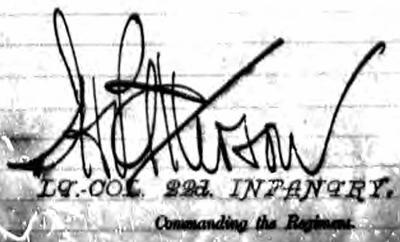
The signature of John H. Patterson as a
Lieutenant Colonel and temporary Commanding Officer 22nd Infantry
on the monthly Return of the 22nd Infantry for March 1897.
|
Newspaper clipping
dated July 3, 1898, |
John H. Patterson was awarded...
the Medal of Honor, as a 1st
Lieutenant of the 11th Infantry,
for most distinguished gallantry in action at the Wilderness,
VA., May 5, 1864,
while under the heavy fire of the advancing enemy, in picking up
and carrying several hundred yards,
to a place of safety, a wounded officer of his regiment, who was
helpless and otherwise have been
burned in the forest.
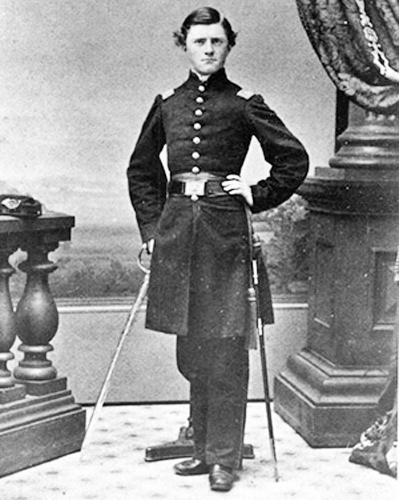
John H. Patterson as an officer in the 11th Infantry during the Civil War
Photo from the National Park Service
Lt. John Patterson and the Medal
of Honor
Battle of the Wilderness
Excerpted from "John H. Patterson: Hero of the Civil and
Spanish-American Wars"
BY JOSEF W. ROKUS
NOTE: In 2010 the Civil War Trust preserved 49 acres of the
Wilderness battlefield. This land in Saunders Field was near
where Lt. Patterson and the 11th U.S. Infantry were located on
May 5, 1864, the day that John Patterson earned the Medal of
Honor.
This land has since been transferred to the Fredericksburg and
Spotsylvania National Military Park.
Lieutenant Patterson at the Battle of the Wilderness
Lieutenant John H. Patterson was assigned to the 11th U.S.
Infantry Regiment, which at the time was commanded by
Captain Francis Cooley. The regiment was part of the 1st Brigade
(Brig. Gen. Romeyn B. Ayres), which reported to the
1st Division (Brig. Gen. Charles Griffin) which, in turn, was one
of the divisions in the 5th Corps, commanded by
Maj. Gen. Gouverneur K. Warren.
On the morning of May 5, Union pickets observed a force of
Confederates moving up the Orange Turnpike (Ewell’s Corps),
and they hastily constructed earthworks along the western edge of
Saunders Field, a clearing intersected by the Turnpike.
Grant and Meade directed Warren to attack immediately, but Warren
hesitated because the Confederate formation overlapped
his right flank and would enfilade him if he advanced. He
beseeched Meade to postpone the attack until Maj. Gen. John
Sedgwick
with his 6th Corps could arrive on the battlefield. By 1:00 PM,
however, Meade had become so exasperated with Warren’s delay
that he ordered him to proceed without Sedgwick.
Griffin’s men, including Ayres’ Brigade and the 11th
U.S. Infantry Regiment, strode across Saunders Field into intense
Confederate firepower. Ayres’ Brigade, on the far right of
the line on the north side of the Orange Turnpike, was blistered
by
Southerners shooting from behind earthworks not only to their
front but also on their right. Many of Ayres’ men were
forced to
fall back across the field, seeking refuge in a gully. Lieut.
Col. William H. Powell, 11th U.S. Infantry Regiment, later wrote,
“The tremendous roll of firing excluded all other sounds.
Here and there a man toppled over and disappeared, or springing
to
his feet, pressed his hands to the wounded part and ran to the
rear. Men’s faces were sweaty black from biting cartridges,
and a sort of grim ferocity seemed to be creeping into the
actions and appearance of everyone within the limited range of
vision.
The tops of the bushes were being cut away by the leaden missiles
that tore through them, and occasional glimpses of gray,
phantom-like forms crouching under the bank of cloud were
obtained.”
At one point during the heavy fighting, Warren thrust an
artillery section into Saunders Field, which began lobbing shells
into
friend and foe. When the Federals came tumbling back, Rebels
swarmed into the abandoned cornfield and captured the guns.
Warren’s riflemen prevented the Southerners from hauling off
the pieces – at least until the night of May 6 - 7 when,
under the cover of darkness, the Confederates dragged the
artillery pieces into their lines.
Around 3:00 PM, Sedgwick’s lead elements reached Saunders
Field. By then, much of the fighting there had sputtered to a
close, although Sedgwick and Ewell engaged in an hour of confused
and bloody combat before both sides disengaged and
began erecting earthworks. Although some combat continued later
that afternoon and evening, at the end of the day neither side
could claim victory at Saunders Field.
In the midst of the fighting, brush fires erupted on the
battlefield. Wounded men from both armies watched in horror as
their comrades were consumed in flames. As best they could and at
the risk of becoming casualties themselves, soldiers from
both sides tried to carry the wounded out of the fast-spreading
fires to safety, but some could not be reached, and they
were burned alive. “Suddenly, to the horror of the
living,” wrote a member of the 7th Indiana Regiment who was
lying along
the Turnpike, wounded, “fire was seen creeping over the
ground, fed by dead leaves which were thick. All who could move
tried to get beyond the Pike, which the fire could not cross.
Some were overtaken by the flames when they had crawled but
a few feet, and some when they had almost reached the road. The
ground, which had been strewn with dead and wounded,
was in a few hours blackened, with no distinguishable figure upon
it.”
Another historian has described the fires at Saunders Field as
follows: “Ignited by powder sparks, fed by dry underbrush
and
stoked by the wind, flash fires flared up across the battle
lines. The flames exploded many of the cartridge boxes strapped
to
the bellies of the fallen, blowing bloody holes in the helpless,
screaming victims. A New York Zouave viewed the horror and
recalled,
‘The almost cheerful “Pop! Pop!” of cartridges
gave no hint of the almost dreadful horror their noise
bespoke…The bodies
of the dead were blackened and burned beyond all possibility of
recognition.’”
Finally, today’s National Park Service historical marker at
the Wilderness Battlefield Exhibit Shelter at Saunders Field
states,
“Brush fires added to the horror of the Wilderness fighting.
Ignited by muzzle blasts and fueled by dead leaves and twigs,
fires swept through the dry woods, obscuring soldiers’
vision and filling their lungs with suffocating smoke. ‘Two
thousand men,
inspired with the desperation of demons’ wrote one soldier,
‘were fighting in a wilderness of fire.’ Hundreds of
wounded men,
unable to escape the devouring flames, suffered an agonizing
death. Others, unwilling to endure such a fate, chose instead
to take their own lives. Union artilleryman Frank Wilkerson saw a
man with two broken legs lying between the lines. Next to him
lay a loaded rifle. ‘I know he meant to kill himself in case
of fire,’ wrote Wilkerson, ‘knew it as surely as though
I could read his thoughts.’”
Lt. John H. Patterson received his Medal of Honor because he
“picked up and carried several hundred yards to a place of
safety
a wounded officer of his regiment who was helpless and would
otherwise have been burned in the forest” on May 5, 1864,
at the Battle of the Wilderness. That officer was Lt. Wright
Staples of the 11th U.S. Infantry.
Patterson Receives His Medal of Honor 33
Years Later
(Website editor: Note: John H. Patterson was awarded the Medal of
Honor in 1897 while he was stationed at
Fort Crook, Nebraska with the 22nd Infantry.)
Patterson was awarded his medal in 1897, 33 years after he
rescued Lt. Staples from the battlefield at the Battle of the
Wilderness
in 1864. This delay was not unique, however, because only about
one third of the Civil War Medals of Honor were awarded by 1870.
While stationed at Fort Crook, Nebraska, Patterson’s
daughter, Elizabeth, describes the scene when Patterson received
a letter
from Secretary of War R.A. Alger notifying him that he had been
awarded the Medal of Honor.
I remember the day my father’s medal came. We were sitting
around the dining table at our noon meal. It was the great day
of the week, the day of the Eastern mail. My father came in to
the table with a letter in his hand: a long envelope with black
printing
in the corner. I was looking at him as he opened it. His face
went very red, then drained slowly white. He looked up; something
seemed the matter with his throat - he could not speak. Then he
reached over our heads and handed the letter to our grandmother.
She read it, and her first look was for us. I remember her voice.
"Children," she said, "your father has been
awarded the Medal of Honor by the Congress of the United
States."
Her manner was formal and unfamiliar. My father recovered
himself.
Patterson’s Medal of Honor
award was initiated by him in an affidavit written in December
1893 while he was stationed as a major with
the 3rd U.S. Infantry at Fort Snelling, Minn. The following are
the key points in that document:
Patterson was serving as
a first lieutenant and company commaner with the 11th
U.S. Infantry at the
Battle of the Wilderness on May 5, 1864.
Lt. Wright Staples, who was on the skirmish line, was wounded in the abdomen and fell.
As the skirmish line was driven back, it was an “every man for himself” situation.
Patterson picked up
Staples from where he had fallen and carried him 200 or
300 yards to the rear, out of fire, where Patterson
stopped a stretcher party. By then Staples had died in
Patterson’s arms. [NOTE: The word "fire"
in the affadavit can be interpreted
as “gunfire” or as “flames” fire.]
Staples was carried to
the rear of the reserve line where the battalion’s
commanding officer, Captain Francis M. Cooley,
took possession of Staples' valuables and personal
effects. Staples’ body was then sent to the division
hospital and
subsequently buried across from the Orange Court House
Road. [NOTE: This road was more
commonly known as the Orange Turnpike at the time and is
now identified as State Route 20.]
The above is excerpted from:
JOHN H. PATTERSON
HERO OF THE CIVIL AND SPANISH-AMERICAN WARS
by Joseph W. Rokus
from the Civil War Trust website
To read the full and excellent
detailed story of John H. Patterson by Joseph W. Rokus click on
the following link which will open a PDF file.
To return to this website click on the back arrow at the top of
the PDF file.
JOHN H. PATTERSON
HERO OF THE CIVIL AND SPANISH-AMERICAN WARS
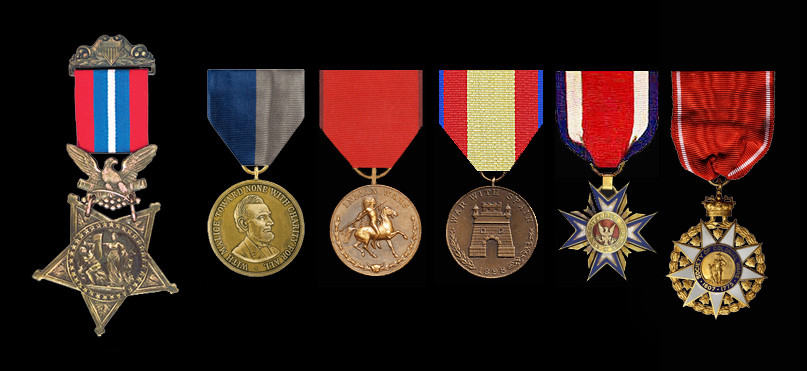
John H. Patterson's decorations
The Medal of Honor is the style he was awarded in 1897.
A portrait of John H. Patterson
in his Brigadier General's uniform From the National Park Service |
The original Medal of Honor From the National Park Service |
Burial:
Albany Rural Cemetery
Menands
Albany County
New York, USA
Plot: Section 42, Lot 13
GPS (lat/lon): 42.70569, -73.73116
|
Grave of Photo by: From the Flickr website |
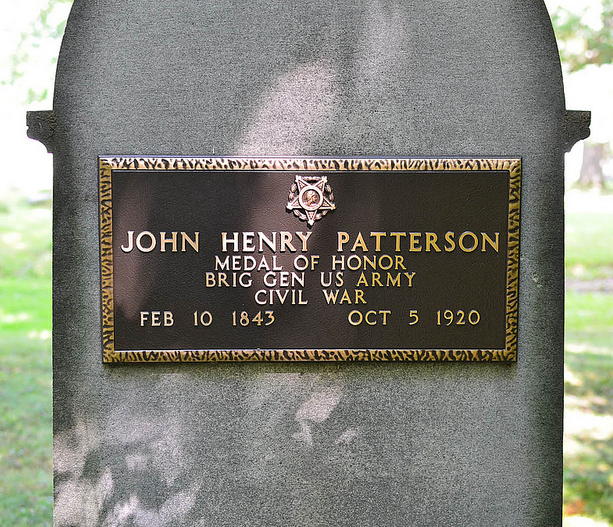
Grave of John H. Patterson
Photo by:
Dave IFOTO4MENOW
From the
Flickr website
Home | Photos | Battles & History | Current |
Rosters & Reports | Medal of Honor | Killed
in Action |
Personnel Locator | Commanders | Station
List | Campaigns |
Honors | Insignia & Memorabilia | 4-42
Artillery | Taps |
What's New | Editorial | Links |